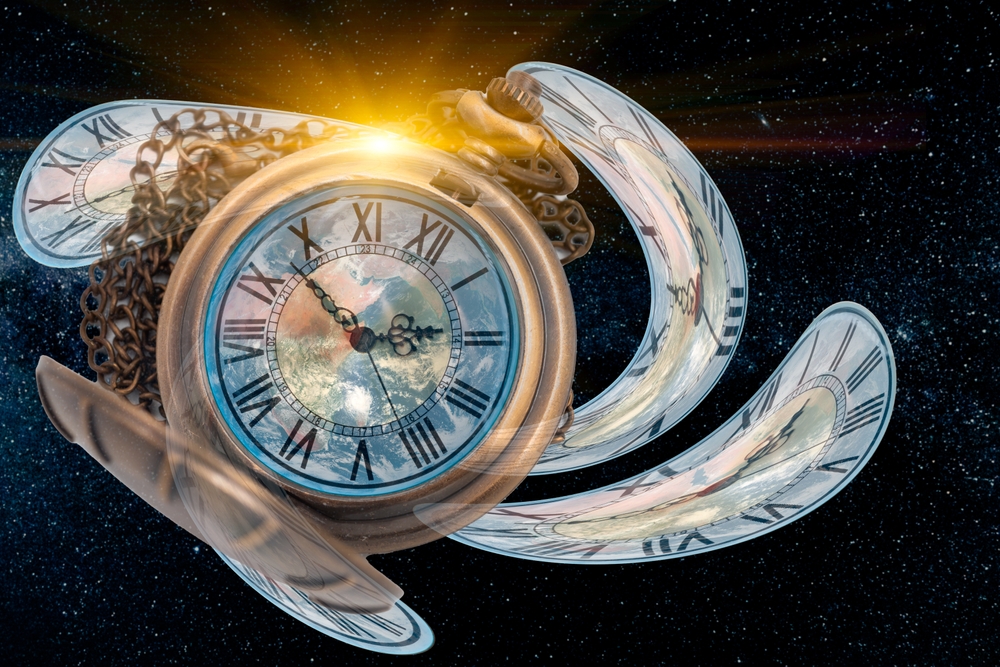Experts Say ‘Time Mirrors’ Are Actually a Real Thing: ‘Like Pressing Undo on the Universe’

What if, instead of replaying a memory in your mind, you could actually rewind reality itself—like scrubbing backward on a video, but in the real world?
It may sound like science fiction, but in a feat that seems to challenge the very fabric of time, physicists have created what they call a “time mirror”—a device that doesn’t just reflect light or sound, but flips the direction of time for the waves it encounters. This isn’t about time machines or paradoxes; it’s about manipulating the flow of information in a way that until now existed only in theory.
For over 50 years, the idea of time reversal was quietly tucked inside complex equations and fringe hypotheses, dismissed as too abstract or too ambitious for the lab. But thanks to a team of researchers in New York, that mental model has snapped into physical form. Their discovery has left scientists stunned—and the rest of us wondering: what else about time isn’t as fixed as we thought?
From advanced physics to the architecture of the human brain, we’re beginning to uncover surprising ways in which time doesn’t just move forward—it can be bent, flipped, and maybe even reengineered.
What Are Time Mirrors?
We’re all familiar with mirrors in the everyday sense—surfaces that reflect light to show us our own image. What we see in a mirror is a spatial reflection: a wave (usually light) hits a surface and bounces back. The direction of the wave changes, but the flow of time remains untouched. That’s the world we know. Time mirrors, however, are a radical departure from this norm.
Rather than sending a wave back in space, time mirrors flip it in time. Imagine dropping a pebble into a pond and watching the ripples move outward—now imagine those ripples suddenly reversing, returning to the point of impact as if someone hit rewind on the universe. That’s the kind of phenomenon scientists have now observed, not metaphorically, but physically.
In a landmark experiment led by Dr. Hussein Moussa and his team at the Advanced Science Research Center at the City University of New York, physicists created a material environment where electromagnetic waves could be sent backwards in time. When the properties of the material were altered in an ultra-fast, uniform burst, the wave traveling through it was forced to reverse its temporal direction. This is what makes a time mirror fundamentally different—it manipulates when a wave exists, not just where it goes.
‘Time mirrors’ are actually a real thing, experts say: ‘Like pressing undo on the universe’ https://t.co/t3tqD5ZoAN pic.twitter.com/9I0lTrgBOv
— New York Post (@nypost) May 23, 2025
To make this concept more tangible, Dr. Moussa described it as akin to seeing your back in a mirror instead of your face. Or hearing a sound not echoed back at you, but reversed, as if time itself has hiccupped. The wave doesn’t just reflect—it rewinds.
This moment marked a shift from speculation to demonstration. Physicists had theorized for decades that if a wave’s environment could be altered quickly enough, time reversal might be possible. But generating that kind of sudden, uniform change proved to be the barrier. Until now.
Time mirrors don’t require any fantastical manipulation of spacetime—they simply exploit the physics of wave propagation in environments that change fast enough to disrupt the flow of energy. And while the effect only applies to part of a wave and for a fleeting instant, its implications ripple far beyond the lab.
The Science Behind the Breakthrough

At the heart of the time mirror experiment lies a special class of engineered materials known as metamaterials—substances designed at the microscopic level to interact with waves in ways that natural materials cannot. These are not just clever composites; they’re tailor-made to bend, twist, and, in this case, reverse the rules that govern light, sound, and electromagnetic signals.
In the study led by Dr. Hussein Moussa and his colleagues at the City University of New York, researchers built a strip of metal embedded with an array of precisely tuned electronic switches connected to capacitor banks. When these switches were triggered in perfect unison, they caused an abrupt, uniform change in the material’s impedance—a property that determines how much a material resists electrical flow. It was this sudden shift that flipped the wave in time.
To understand why this is revolutionary, it helps to consider how waves typically behave. When a wave—say, an electromagnetic signal—travels through space, it carries energy forward in time. Its characteristics, like frequency and amplitude, evolve predictably. But if the medium through which the wave moves changes suddenly enough, the wave is forced to adapt in real time. If the change is both rapid and global, it can do something extraordinary: cause part of the wave to reverse its temporal direction.
This is not the same as bouncing off a wall or reflecting off a mirror. In traditional spatial reflection, the wave’s position and direction change, but its timeline remains linear. In time reflection, however, the wave actually retraces its own steps. The researchers observed the reversed wave emerging with a new frequency, confirming that the time axis—not just space—had been manipulated.
What made this experiment possible, after decades of theoretical roadblocks, was the precision with which the researchers controlled the switching event. Previous attempts failed because they couldn’t achieve a sufficiently uniform or sudden transformation across the entire material. Dr. Moussa’s team overcame this by engineering a synchronized release of stored energy, effectively doubling the impedance of the medium in an instant—a key requirement predicted by earlier mathematical models of time reflection.
Real-World Applications and Implications
‘Time mirrors’ are actually a real thing, experts say: ‘Like pressing undo on the universe’ > https://t.co/eYbicdB8L2 pic.twitter.com/nfzHX89WUb
— Albert Einstein (@AlbertEinstein) May 28, 2025
Time mirrors aren’t just a laboratory curiosity—they offer a gateway to technologies that could reshape how we communicate, compute, and even understand reality itself. From practical tools to profound questions about time and causality, the implications are as expansive as they are urgent to explore.
1. Rethinking Communications: Speed, Accuracy, and Security
Time mirrors introduce the possibility of manipulating not just where signals go, but when they go. This opens up transformative possibilities in telecommunications. Imagine a system that could reverse corrupted data packets in real time—essentially allowing for instant error correction, like hitting rewind on a glitch in a live broadcast.
The built-in time reversal also shifts wave frequencies, which could serve as a natural form of frequency-based encryption. A message that alters itself while traveling is harder to intercept, making time-reflected communication far more secure. For military and cybersecurity applications, this could mean safer, less detectable transmissions.
2. Temporal Cavities: Bouncing Waves Between Time Surfaces
Scientists envision systems where two time mirrors are used together to create what they’re calling temporal cavities—environments where waves bounce back and forth not in space, but in time. This bizarre-sounding setup could lead to signal behaviors that defy conventional expectations, such as self-interference patterns that enhance detection sensitivity.
These effects could be applied to advanced sensors and imaging devices, offering unprecedented clarity and resolution. In fields like medical diagnostics, earthquake prediction, or deep-space observation, being able to isolate or enhance faint signals may open new scientific frontiers.

3. Future Data Storage and Logic Systems
Beyond communication and sensing, researchers are beginning to speculate about time mirrors’ role in computation and data handling. Could a signal, once reversed, be used as a form of data recall or memory? If information can loop or be mirrored in time, then theoretically, it could form the basis of novel storage elements or logic gates.
While still largely conceptual, this could represent a new architecture for computing—one that’s not only faster or smaller, but fundamentally different in how it processes and retrieves information.
4. Ethical and Practical Challenges
As with any disruptive innovation, time mirrors come with a host of ethical considerations. If you can delay, reverse, or scramble a signal in time, how do you verify authenticity? Could bad actors use temporal scrambling to conceal data tampering or fabricate communications?
Questions around control and oversight are inevitable. Much like facial recognition or quantum encryption, time-based manipulation of information will require guidelines to ensure it’s used to advance, not erode, trust and accountability in technology.
5. Rewriting the Rules of Causality
Perhaps the most profound implication of all is philosophical. Time mirrors challenge the idea that causality flows in only one direction. If energy, in the form of waves, can be reversed, then our models of cause and effect may require revision.
This isn’t just theoretical musing—it’s a direct result of observable phenomena in controlled environments. And it reminds us that time, long treated as a rigid backdrop to events, may actually be an active variable—one that, under the right conditions, we can now begin to shape.
Time and the Brain: A Fascinating Parallel

While physicists are learning to reverse time in the lab, neuroscientists are uncovering something equally remarkable: our brains may already possess a natural ability to navigate time internally. The discovery of “time cells”—specialized neurons that mark the sequence of moments—suggests that our perception of time isn’t merely passive but actively constructed by the brain.
In a 2021 study led by neuroscientist Leila Reddy, researchers at institutions in France and the Netherlands worked with patients undergoing treatment for severe epilepsy. These patients had electrodes implanted deep within their brains as part of their medical evaluation, giving scientists a rare opportunity to monitor neural activity in real time. What they found was striking: even in the absence of external cues like clocks or light, certain neurons fired in consistent sequences that appeared to track the passage of time.
These “time cells” essentially function as an internal chronometer, helping us not only remember events but place them in a timeline. According to Reddy, this may be the very mechanism that allows for episodic memory—the ability to recall not just what happened, but when and in what order. In other words, our brains might be flipping through our past like a mental VHS tape, constructing a sense of continuity that’s crucial for identity, decision-making, and planning.
The connection to time mirrors lies in this shared defiance of linear time. Just as metamaterials can send waves backward in time, the brain can revisit past moments, simulate future ones, and reorganize memories based on new information. In both cases, time is not simply flowing forward—it’s being actively shaped.
A New Way of Thinking About Time

Time has always seemed immutable. It moves in one direction—forward—ushering us from past to present to future with a rhythm as steady as a heartbeat. But discoveries like time mirrors and time cells are forcing scientists, philosophers, and the rest of us to question that deep-seated certainty.
At the core of modern physics lies the concept of the “arrow of time,” a principle rooted in entropy: disorder increases, eggs don’t unscramble, and broken glass doesn’t reassemble. Time, in this view, flows only one way because energy dissipates and systems become more chaotic. But time mirrors disrupt that logic—at least for a moment. By carefully controlling the environment through which a wave travels, researchers have shown that part of that wave can flow backward in time, retracing its steps in defiance of entropy’s usual script.
This doesn’t mean we’re on the verge of reversing entire systems or undoing history. But it does prove that under the right conditions, small-scale reversals are physically possible. The implications ripple outward: if information can momentarily move backward, could other systems—biological, technological, even societal—be designed to reset, rewind, or self-correct in similar ways?
Meanwhile, in the realm of the mind, time is equally fluid. The brain’s time cells allow us to leap between past and future in thought, creating an internal world where timelines blur. This subjective experience of time—where moments can feel stretched, compressed, or repeated—may reflect deeper truths about how time operates not just in consciousness, but in the universe.
These developments suggest a shift in perspective: time may not be a rigid track we ride, but a dimension we can, under certain conditions, influence. Just as we’ve learned to manipulate space through architecture, technology, and transportation, we may one day learn to interact with time in ways previously considered impossible.
This new understanding doesn’t discard the old—it deepens it. It invites a more nuanced view of time as both directional and dynamic, shaped by context, environment, and even intention. Whether in the lab or in our memories, we are beginning to see that time is not merely something we endure—it’s something we might one day learn to design.
Why This Discovery Belongs in the Public Imagination
At first glance, time mirrors might seem like an abstract curiosity—an esoteric trick of waves in a lab. But peel back the layers, and they touch something deeply human: our desire to understand, influence, and perhaps even rewrite the course of events.
In a world that often feels stuck on fast-forward, the idea of “pressing undo on the universe” resonates far beyond physics. It speaks to our collective fascination with second chances, with memory, and with the mysterious rhythm that governs our lives. Time is the backdrop to everything we experience—love, loss, growth, and change. So when science shows that time isn’t as fixed as we thought, it doesn’t just shift a paradigm—it sparks the imagination.
That’s why this discovery belongs in the public consciousness. Not because we’re suddenly on the brink of time travel, but because it marks a profound moment where experimental physics meets existential wonder. It’s a reminder that the universe is still full of surprises—and that the limits we’ve accepted may be more negotiable than we assumed.
It also offers a humbling insight: even in our most advanced technologies and theories, we are just beginning to scratch the surface of what’s possible. Time mirrors challenge us to look at information, memory, and reality itself through a new lens—one that’s not constrained by what has been, but open to what might be.
In an age where misinformation spreads faster than truth and where attention is fragmented by noise, breakthroughs like this provide something rare and valuable: a sense of awe rooted in real, rigorous science. They invite us to ask not just how the world works, but what we might dare to imagine next.
Because if time can flip—if the arrow doesn’t always have to point one way—then maybe, just maybe, the future is more open than we ever dreamed.
Loading...

